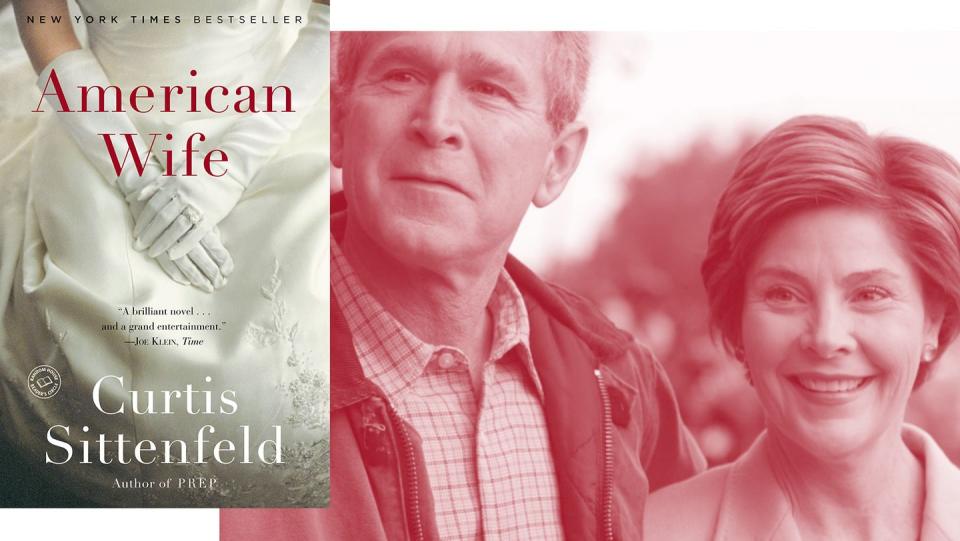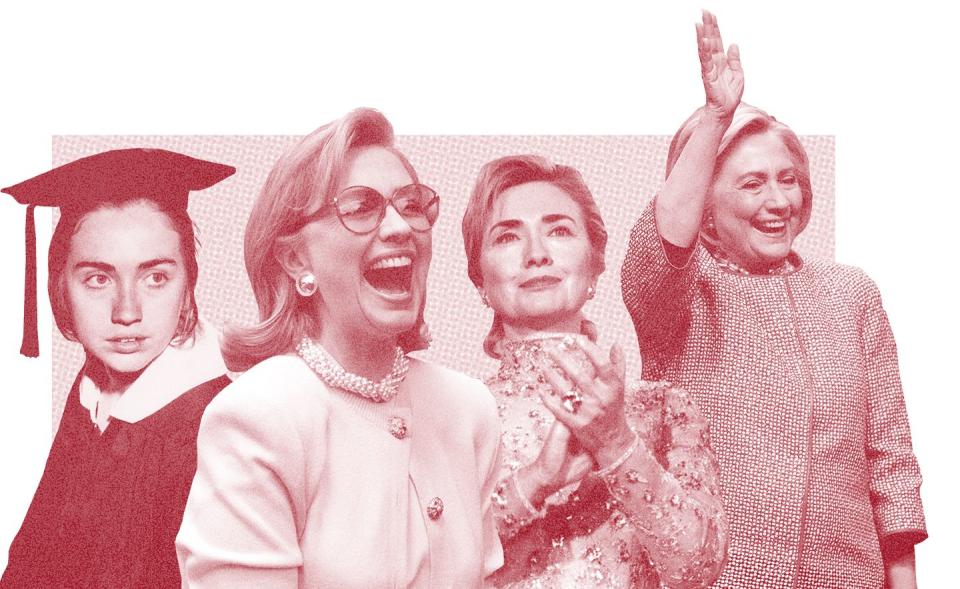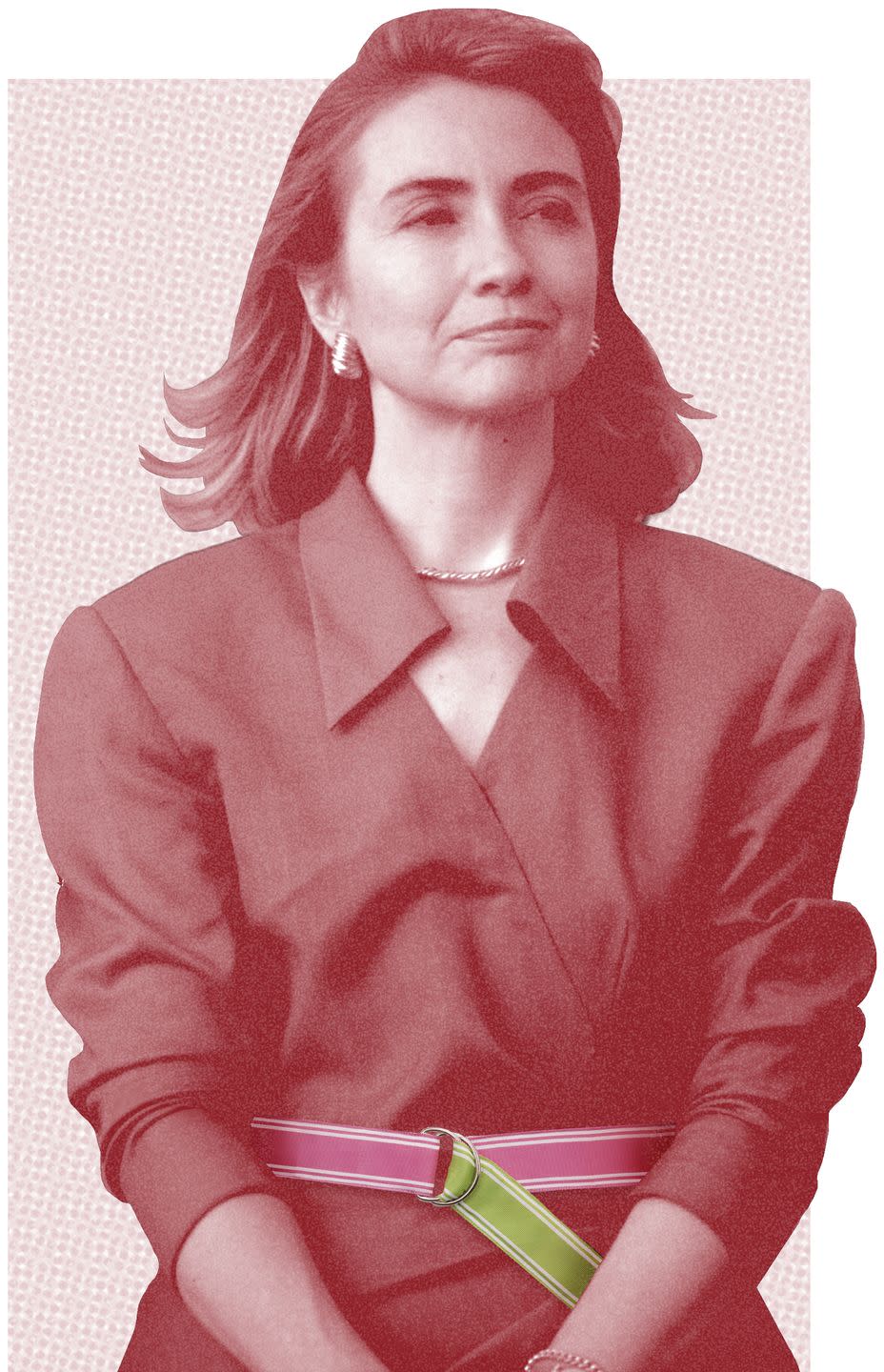Curtis Sittenfeld’s Hillary Clinton Novel Might Start a Fight at Your Book Club

A note to any book clubs planning to read Curtis Sittenfeld’s Rodham: Beware. It’s not difficult to imagine the audacious novel—an amalgam of fan fiction, alternative history, and political satire that imagines what Hillary Clinton’s life would have been like had she never married Bill Clinton—will provoke more than a few post-wine-and-cheese fist fights.
When I mention this to Sittenfeld, she laughs and says, “we can’t please everyone.”
It’s a fittingly diplomatic response for an author writing about one of the most polarizing politicians of our time. Sittenfeld is well aware that her subject is not universally beloved. In her short story “The Nominee”, published in Esquire in May 2016 and told from the point of view of an unnamed but Hillary-like character, an aide tells the protagonist, “it’s no secret that you’ve always been a Rorschach test for people in terms of where they stand on things like feminism and women in the workforce.”
The Hillary character responds: “Surely you realize that no one sees herself as a symbol?”
Writing the short story inspired Sittenfeld to devote a full novel to Hillary, and a central concern of Rodham is revealing the person underneath the carefully curated pantsuit, and the expectations and judgments that have been heaped on her. Hillary Clinton has always seemed somewhat unknowable, so how does Sittenfeld use the lens of fiction to make this real-life person feel, well, realer?
Rodham is realistic but not real, the kind of book where fact and fiction blur. “Some of what I’ve written can sound kind of gimmicky, and this, in a literal sense, is gimmicky, but I think it’s totally sincere,” Sittenfeld tells me. “It’s trying to enact what a plausible and realistic parallel universe is.”
There’s an awful lot of nuance in Rodham, perhaps more than diehard Clinton supporters will enjoy. In Sittenfeld’s version of the world, Hillary has flaws—she gets uncomfortably close with a married colleague, she’s not entirely discerning regarding where political donations come from. How readers react to such foibles might depend on how they feel about Hillary overall. “It’s more interesting and more realistic not to make my version of Hillary Clinton saintly,” Sittenfeld says. “Some people still might think I did, but I think in the book she makes a few questionable choices. To me, that’s realistic of anyone.”
Sittenfeld values the freedom that writing fiction allows her, especially to eschew moral judgment. “If the novel had a strong message, I would have just written an opinion piece,” she says. “I think that novels allow you to consider a lot of different ideas.”

Clinton has been a beguiling subject for many writers and filmmakers over the years, from Carl Bernstein, who wrote the 2007 biography A Woman In Charge, to Nanette Burnstein, whose docuseries Hillary premiered at the 2020 Sundance Film Festival and is available to view now on Hulu. Clinton has proven to be a useful canvas for storytellers and yet she still inspires speculation. Over the course of reporting her book Chasing Hillary: Ten Years, Two Presidential Campaigns, and One Intact Glass Ceiling, journalist Amy Chozick spent time with a close friend of Hillary Clinton’s named Sarah Ehrman. “Sarah’s a spitfire of a feminist who drove Hillary to Arkansas to be with Bill and tried to talk her out of it the entire drive,” says Chozick, co-creator and executive producer of the upcoming Netflix series The Girls on the Bus, which is based on Chasing Hillary.
“So, when I heard Curtis was imagining this road not taken—if Sarah's nagging had worked!—it seemed like the perfect fictional path, and Curtis with her eye for detail, empathy and humor, is the perfect novelist to do it.”
Perfect indeed. It’s not hard to imagine that a certain subset of of Hillary’s heartbroken 2016 supporters are longtime fans of Sittenfeld’s books, that they will come to Rodham having absorbed her earlier accounts of adolescence and flawed adulthood.

After all, Sittenfeld debut novel, 2005’s Prep, was a phenomenon, selling more than 133,000 copies in hardcover. Prep follows the experiences of an awkward outsider trying to fit in at an exclusive boarding school—similar in some ways to the tony prep school Groton, which Ohio native Sittenfeld attended—though the author, who later went on to attend Vassar and Stanford and earn an MFA from the Iowa Writer’s Workshop, has insisted it’s not based on her own experience. "In a way it's flattering that it seems so real,” Sittenfeld told a reporter in 2005, the year Prep was published. “But is it so easy to believe that I have no imagination and I can't invent dialogue or those scenarios?"
The New York Times included Prep on its list of top 10 books of 2005, which also features books by Zadie Smith, Haruki Murakami, and Mary Gaitskill; the paper said that Prep “casts an unshakable spell and has plenty to say about class, sex and character.”
Despite some reviews that grappled with the “unlikable” nature of its characters, Prep was that rare bestselling novel that made popular readers consider the idea that not every narrative—especially those with female narrators—requires a clear redemption arc. Readers of Prep have to be okay in the presence of a flawed, privileged heroine who doesn’t learn all that much by the story’s end.

And here’s where we get to the area in the Venn Diagram where female protagonists in novels and American female political candidates have a 100% overlap: likability. “Even when you ask about likability that tends to be a sexist question,” Sittenfeld says with a laugh.
Prep hit a nerve; in 2016, HBO announced it had acquired the rights to the book and was developing a series helmed by veterans of 30 Rock and Game of Thrones. Sittenfeld tweeted a shot of a pilot script she called “as great as My So-Called Life” in 2017, but little about the production has been revealed since. (As far as reviving Prep goes, Sittenfeld once said, "I definitely have an idea for a sequel, but I definitely feel prep-schooled out right now.")
After subverting chick lit clichés in her second novel, The Man of My Dreams, Sittenfeld continued to overturn readers expectations of likability in 2008’s American Wife, a thinly-veiled re-imagining of the life of former First Lady Laura Bush. Critic Sam Anderson called the book “a radioactive, Republican-baiting scandal bomb of a novel” in New York.
The novel tells the story of a humble, liberal librarian named Alice Blackwell who looks the other way at her husband’s frat boy antics and perhaps more damningly his later war crimes. Is Alice a sellout? Perhaps, but she makes for a fascinating main character.
With American Wife Sittenfeld made the Bush dynasty into a compelling beach read. In an interview with Terry Gross, Sittenfeld disavowed their politics but tried to emphasize their humanity. “I think they're real people with likes and dislikes, fears, and little daily habits,” she said. “They have these relationships with their children or their friends, their family members that are probably a lot like the ones that I have with my friends and family members.”

After contemplating the psychic connections of a pair of twins in 2013’s Sisterland and updating Pride and Prejudice in a 2016 modern-day retelling called Eligible, Sittenfeld published her first short story collection, You Think It, I’ll Say It, in 2018. The book features many characters affected and astounded by the Trump presidency, and the collection connected with readers including Reese Witherspoon, whose Hello Sunshine production company optioned the book for a television series, which will star Kristen Wiig. “I just love Curtis Sittenfeld’s characters,” Witherspoon said in May of 2018. “They just feel like people you know.”
Over a video chat out of her home office in Minneapolis, Sittenfeld tells me about texting with a friend to ask how she was doing and receiving the response that she was “pandemic fine.” “And I was like, can I use that,” says Sittenfeld, wearing thick black glasses and a dark fleece over a white T shirt.
“Pandemic fine” has forced a new level of realness on all of us, whether we were ready for it or not. This means I get to peek into Sittenfeld’s home, to observe her at her writing desk, and to feel terrible when her young daughter comes into the office and interrupts our conversation. “I’m actually having an interview about my book,” Sittenfeld tells her daughter. “Go ask Daddy, sweetheart.”
Social distancing Day 12: Today my kids wanted me to wear my wedding dress at lunch & I couldn’t think of a reason not to pic.twitter.com/2snMmwxuGq
— Curtis Sittenfeld (@csittenfeld) March 24, 2020
Still, Sittenfeld has kept her sense of humor and maybe even revealed more of herself than she might ordinarily. See her viral tweet, captioned “social distancing day 12”, in which she wears her wedding gown to eat lunch at the kitchen table, looking appropriately harried.
Sittenfeld used none of that material in this novel—at least not directly. If motherhood seems inextricably tied to Clinton’s version of feminism, then it’s jarring that in the world of Rodham, Hillary is a single woman, never married. Therefore, Chelsea doesn’t exist. “I considered making a reference to Chelsea, but I wanted to do it the right way or not at all,” Sittenfeld says. “I don’t want the tone of my books to be wink-wink. If someone wrote a TV show set in 2005 and said something like, ‘That’s as likely as Donald Trump being president,’ that’s not my thing.” Sittenfeld is too discerning to go for the easiest of jokes.
One area that any Sittenfeld fan knows that she doesn’t shy away from is sex scenes, and Rodham is chock full. Just as in American Wife, the sex here is explicit, intimate, and weirdly hot, regardless of how you might feel about the Clintons. But this time, there’s the added bonus of a saxophone: “The next thing I knew, he’d bounded out of bed, and I was offered an unobscured view of his pale buttocks as he bent, opened the case, and pulled out the golden instrument,” Sittenfeld writes of an early encounter between Hillary and Bill. The scene continues with Bill playing “When the Saints Go Marching In” in the buff.

For all of the comedy and heartache that Bill provides in the novel, Sittenfeld insists that Rodham is not a rebuke of him. “You could hear the premise of this novel and think that it’s very anti-Bill, but when I read the early passages of his autobiography, I thought to myself, if Bill Clinton wanted to marry me in 1975, I would have done it,” Sittenfeld says. “It’s not as if I don’t understand his appeal. I think he’s a complicated person and has profound flaws and strengths.”
But I ask Sittenfeld, as the writer who created the novel’s version of Bill, does she have any further opinions about his character? “I don’t know what my opinion of Bill Clinton is,” she says. “I think one of the reasons that I’m a novelist is that I find a lot of people and situations very confusing.”
Still, there are moments in Rodham that feel like political commentary even if its author insists they’re not. The fictional Hillary becomes a law professor at Northwestern and religiously follows Clarence Thomas’s confirmation hearings, noting when Joe Biden pounds his gavel against the table. “For as long as I live,” muses Hillary the character, “I’ll never forget watching Anita Hill deliver her opening statement: her aquamarine suit, her composure and seriousness, her essential isolation as she faced the row of fourteen white male Senators and the many, many cameras.”

Sittenfeld admits that when she wrote that she did not think Biden would be the 2020 Democratic nominee. “One book I read as research for Rodham is Strange Justice by Jane Mayer and Jill Abramson,” she says. “It’s a very detailed accounting not just of the confirmation hearings, but the upbringings of Clarence Thomas and Anita Hill. Biden is a prominent figure in that story.” She doesn’t say more, except to note that she interviewed Biden in person when his memoir was published in 2017 and felt more favorable to him after that.
Two people whose names aren’t mentioned in Rodhamat all are child sex trafficker Jeffrey Epstein, on whose private plane Bill traveled in 2002 and 2003, and convicted rapist Harvey Weinstein, who was a major fundraiser in Hillary’s 2016 campaign and whom she later renounced. In Rodham, the character Hillary says post-breakup that “I understood suddenly that I was freed from deciding what I believed. If I was no longer his girlfriend, and never his wife, I was not responsible for his behavior, not even by extension. This absolution was my reward for losing him.” Had Hillary not married Bill, one can imagine that she would not have been in close proximity to these sexual predators; it’s a nice fantasy to ponder in the #MeToo era.

Perhaps the most controversial political figure of our time does make an appearance in Rodham, and his invocation is artfully done: the crass, morally bankrupt character of Donald Trump partakes in some shady negotiations with Hillary that highlight how politics sullies nearly everyone involved. Even in a parallel universe where Hillary is unburdened from Bill, she doesn’t escape unblemished; pandering to the rich will always be a part of the American electoral process.
When I suggest that her inclusion of Trump in Rodhamwill anger some readers, Sittenfeld says yes. “Or,” she says, “It just feels like farting in an elevator. Like, why put Trump in your book when you don’t have to?” But some facts about the way we live now are impossible to ignore, and one thing you can always count on in Sittenfeld’s fiction is that there will be no easy answers.
You Might Also Like

